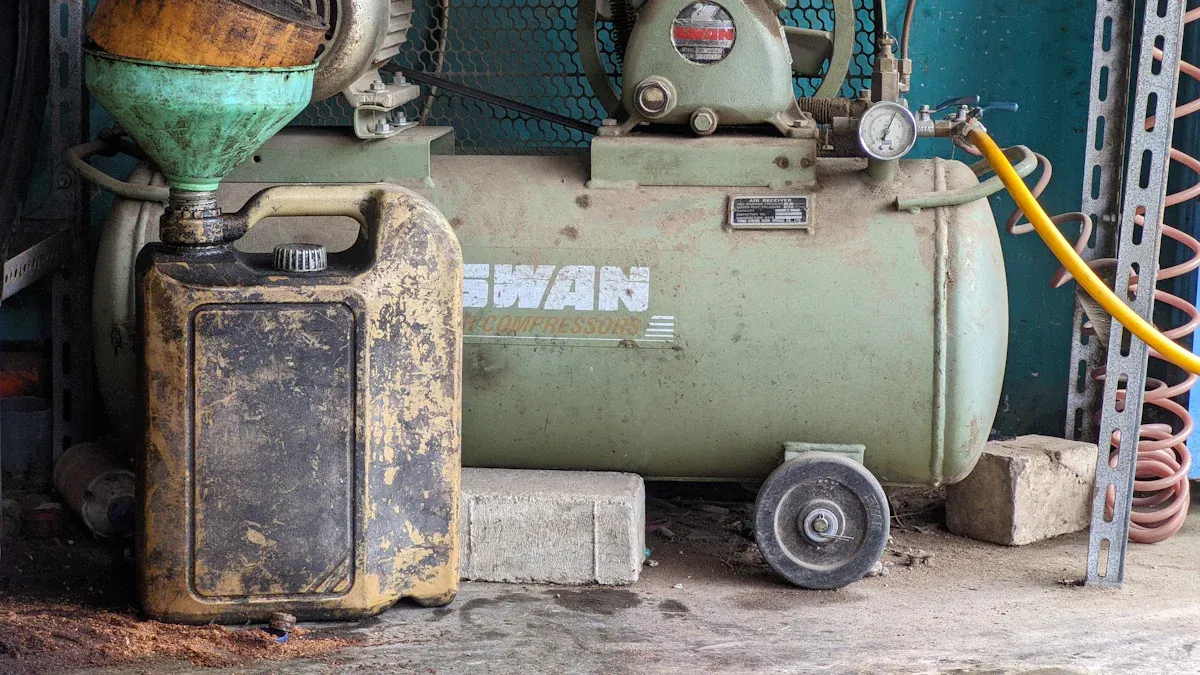
I have seen firsthand that regular maintenance keeps my air compressor running smoothly. Simple checks each day help me spot issues before they become serious. Consistent care not only prevents costly repairs but also extends the life of my equipment. I trust this approach for reliable performance.
I always make maintenance a top priority because I want to avoid unexpected breakdowns. When I check my air compressor regularly, I catch small issues before they turn into big problems. For example, I once noticed a strange noise during a routine inspection. I stopped the machine and found a loose bolt. Fixing it right away saved me from a costly repair and hours of downtime.
Tip: A quick daily check can keep your equipment running when you need it most.
I have learned that a well-maintained air compressor works better and uses less energy. Clean filters and proper lubrication help the machine run smoothly. I notice that when I keep the parts clean and the oil fresh, the compressor reaches the right pressure faster. This means I get more work done in less time.
I see maintenance as an investment, not an expense. When I take care of my air compressor, I avoid expensive repairs and extend its lifespan. I spend less on replacement parts and emergency service calls. Over time, these savings add up. I recommend keeping a simple log of maintenance tasks to track what you have done and when.
I always start my maintenance routine by checking the oil level. The oil keeps the moving parts inside the compressor lubricated and prevents overheating. I remove the dipstick or look through the sight glass to see if the oil sits at the recommended level. If the oil looks dark or gritty, I know it is time to change it. I top up the oil only with the type recommended by the manufacturer. This simple habit protects the motor and extends the life of my air compressor.
Tip: I check the oil before every use, especially if I run the compressor for long periods.
Moisture builds up inside the tank every time I use my compressor. Water can cause rust and damage the tank from the inside. I make it a point to drain the tank at the end of each day. I open the drain valve slowly and let all the water escape. Sometimes, I tilt the tank slightly to make sure all the moisture comes out. This step keeps the tank in good condition and prevents costly repairs.
Leaks waste energy and reduce the efficiency of my compressor. I listen for hissing sounds while the compressor runs. I also feel around the fittings and hoses for escaping air. If I suspect a leak, I use a soapy water solution and watch for bubbles. I tighten any loose fittings with a wrench. Regular inspection helps me catch leaks early and keeps my equipment running at peak performance.
Note: Even a small leak can lead to higher energy bills and longer run times.
Clean air filters keep dust and debris out of the compressor. I remove the filter cover and check the filter every week. If the filter looks dirty, I clean it with compressed air or replace it with a new one. A clogged filter makes the compressor work harder and can shorten its lifespan. I always use filters that match the specifications in the manual.
I schedule oil and filter changes based on the manufacturer's recommendations. Over time, oil breaks down and loses its ability to lubricate moving parts. Dirty oil can cause wear and shorten the life of my equipment. I always use the correct oil type and replace the oil filter at the same time. This routine keeps the internal components clean and running smoothly.
Tip: I set reminders on my phone or calendar to avoid missing scheduled oil changes.
When I change the oil, I let the machine cool down first. I drain the old oil into a container and dispose of it properly. I wipe away any residue before adding fresh oil. For the filter, I check for signs of clogging or damage. A clean filter ensures that only clean oil circulates through the system.
I inspect belts, hoses, and pulleys every few months. Belts can crack or stretch over time. I look for frayed edges or shiny spots, which signal wear. If I notice any damage, I replace the belt right away. Hoses can develop leaks or bulges. I run my hand along each hose to feel for weak spots. Pulleys should spin freely without wobbling or noise.
Note: Worn belts or hoses can cause the air compressor to lose efficiency or stop working altogether.
Vibration from daily use can loosen bolts and connections. I use a torque wrench to check all fasteners during periodic maintenance. I follow the torque specifications in the manual to avoid over-tightening. Loose bolts can lead to leaks, noise, or even equipment failure. I pay special attention to mounting bolts, hose clamps, and electrical connections.
I monitor the operating temperature to protect my air compressor from overheating. High temperatures can damage seals, gaskets, and other components. I check the temperature gauge during use and look for warning lights or error codes. If the unit feels hot to the touch or shuts down unexpectedly, I investigate right away.
Alert: Overheating often signals blocked vents, low oil, or excessive workload. I clean cooling fins and ensure proper ventilation around the machine.
I record temperature readings in my maintenance log. This habit helps me spot trends and address issues before they become serious.
I always pay close attention to where I install my air compressor. I choose a flat, stable surface to prevent vibration and movement. I make sure the area has enough space around the unit for airflow and easy access during maintenance. I avoid placing the compressor near walls or corners that can block ventilation. Good placement helps the machine run cooler and reduces the risk of overheating.
Tip: I check the manual for recommended clearances and follow them closely.
I never push my air compressor beyond its rated capacity. I check the specifications before connecting tools or equipment. If I notice the compressor running non-stop or struggling to keep up, I take a break and let it cool down. Overloading can cause excessive wear and shorten the life of the machine. I plan my work schedule to give the compressor time to rest between tasks.
I keep my air compressor in a clean, dry environment. Dust and moisture can damage internal parts and reduce efficiency. I avoid using the compressor in areas with extreme temperatures or high humidity. If I must operate in tough conditions, I use covers or enclosures to protect the unit. Regular cleaning of the surrounding area helps prevent debris from entering the system.
Note: I always check for signs of rust or corrosion, especially after working in damp locations.

I always pay attention to the way my air compressor sounds and operates. Unusual noises, such as rattling or hissing, often signal trouble. I also watch for drops in pressure, longer run times, or excessive vibration. These signs usually mean something needs attention. When I notice oil leaks or moisture around fittings, I investigate right away. I have learned that catching these warning signs early prevents bigger problems later.
Tip: If the compressor trips the breaker or overheats, I stop using it and check for blockages or low oil.
I handle many small repairs myself, like tightening fittings or replacing filters. I use a basic toolkit and follow the manufacturer’s instructions. For electrical issues or persistent leaks, I call a professional. I never try to fix wiring or internal components on my own. Safety comes first. I trust certified technicians for complex repairs or annual servicing.
I maintain a simple logbook for all maintenance tasks. I record dates, actions taken, and any parts replaced. This habit helps me track patterns and spot recurring issues. When I schedule professional service, I add those details as well. Good records make troubleshooting easier and support warranty claims.
Note: Consistent documentation keeps my air compressor running reliably year after year.
I always make regular maintenance a priority. Quick action on small issues keeps my equipment running smoothly. When I face complex problems, I call a professional.
Protect your investment by following these tips for reliable performance.
I follow the manufacturer's guidelines. For most models, I change the oil every three months or after 500 hours of use. Clean oil keeps my compressor running smoothly.
I check the power supply first. I inspect the fuse and reset the breaker. If the problem continues, I call a professional technician for help.
I never use automotive oil. I always choose oil designed for air compressors. Specialized oil protects internal parts and prevents premature wear.
Tip: Always check your manual for the recommended oil type.
-
